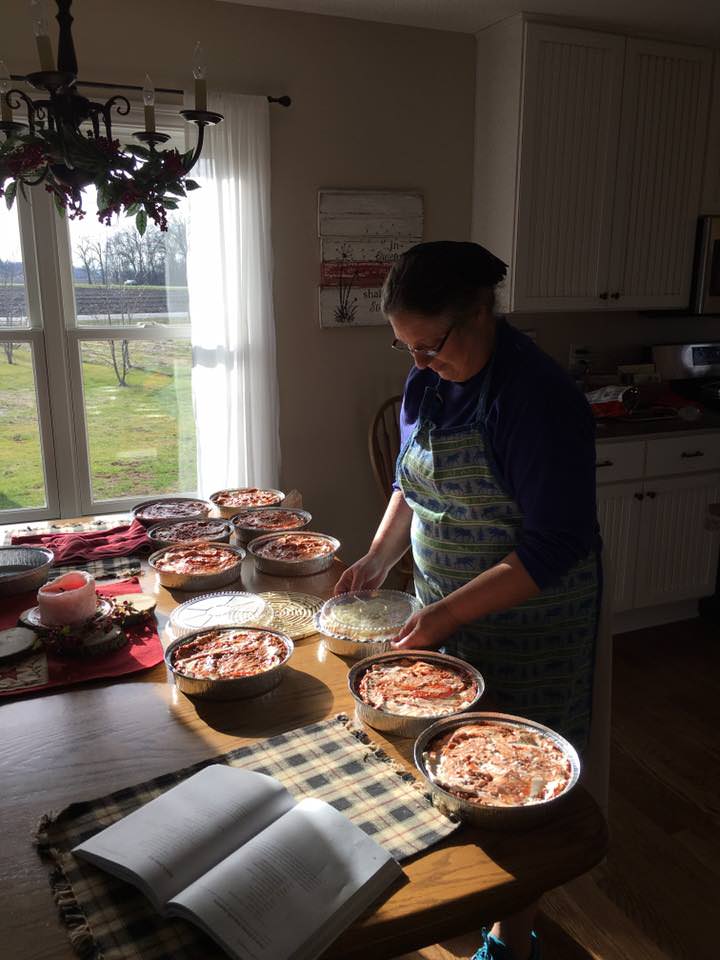Lovina Gingerich's gas stove...her kitchen is a tidy icon from another era...
By Kevin Williams (scroll to the end to get the updated recipes!)
I’ve written many times over the years that I caught my first-ever glimpse of the Amish in Adams County’s Ohio’s rocky hills when I was a teenager. I can still remember the first time I saw the charcoal-black buggy, the bearded man with the wide-brimmed hat, and the horse-drawn plows in the field.
Except I’ve been wrong. That wasn’t my first glimpse of the Amish.
It actually happened years earlier.
“NO SUNDAY SALES”
I remember the sign quite clearly, hanging outside a farmhouse on Route 42. And visible lettering that said: “Harness Shop.” I made a mental note of this curiosity in my 8-year-old mind and then promptly forgot about it until researching this story. I had unknowingly caught a glimpse of my first Plain settlement and what was one of the last pillars of a place once teeming with Amish activity, a place where Amish woman Rachel Miller held the distinction of being the only Amish female that ran a harness shop (chronicled somewhat loosely in Stephanie Reed’s fiction book, The Bargain)
Plenty of businesses that trace their roots to the Amish can still be found around Plain City
There were once three thriving Amish church districts in this area of rural roads and farmland just northwest of Columbus, Ohio, a major city with a massive university, research institutions and financial hubs. US Route 42, which cuts through Plain City, was once dotted with Amish-owned bakeries, harness shops and restaurants serving up homestyle cooking. And hitching posts were as common in Plain City as the Amish people who went about their business at local banks and hardware stores. In fact, there were so many Plain people – Amish and Mennonites – that some people incorrectly believed Plain City’s name derived from them. This is historically inaccurate as the village was christened Plain City in 1851 over 40 years before the first Amish arrived.
The Amish are a culture that once roots sink into a community they travel deep and far, and family and tradition and faith often anchor them in place seemingly forever. The first Amish arrived in Holmes County, Ohio some 100 miles northeast of Plain City in 1809 and have never left. Lancaster County, Pennsylvania remains a huge Amish community over 200 years after the first Amish arrived. But in Plain City, the Amish arrived, thrived and then seemingly vanished. Where did they go? And why did they leave?
There are no horse-drawn buggies clattering down the rural roads outside of Plain City anymore. But there is plenty of evidence the Amish were once here. Businesses bear common surnames of the Amish. And there’s even a road called Amish Pike which angles through what was once the heart of the Amish community. But there are no buggies, no colorful laundry on lines, nor windmills spinning in the sky.
“The last horse and buggy in the area would have been the Millers, and that was back in the mid-1990s” recalls Lovina Gingerich.
A gaslight in Lovina's kitchen
Lovina would know. Because as the Amish gradually streamed out of Plain City a handful remained, tethered to the area by fond memories of a storied past and a desire to live out their lives in the town they loved. Today five elderly Amish ladies remain of what was once a community of Amish numbering in the hundreds.
The remaining Amish are ages 91, 87, 88, either widows or never married. Among them are also Lovina Gingerich, 84 and her younger sister, Minvera, 77.
For now Lovina Gingerich doesn’t seem like she’s in a hurry to go anywhere other than her usual rounds.
“I don’t have all day to talk to you, I am very busy,” Gingerich says politely, but firmly.
Gingerich has a slight build her wispy white hair swept up under her snow-colored kapp and matching dress. Her slight build conceals a steely resolve.
Between being a full-time caregiver to her sister Minvera, working one day a week at a local antique shop, and doing the bookkeeping for Yoder’s Hardware in Plain City, Lovina can be forgiven for seeming like a woman in a hurry.
The first Amish families arrived in Madison County in 1896 attracted to the area by the cheap, arable farmland. In retrospect, the community might have been doomed from the start. The establishment of an insular community so close to metropolitan Columbus was what ultimately helped to destroy it. However, in 1896, the city center was 30 miles away and the interstate system, which now cuts just 8 miles east of Plain City, was 60 years in the future.
The western edge of Columbus’s suburban sprawl has crept into and transformed Plain City. A gleaming McDonald’s serves up artisianal chicken sandwiches and smoothies two miles from the Gingerich house. Step into the Gingerich house, though, and one feels if they’ve stepped into another time. Gas lights, no car, an impeccably polished wood floor, plain dresses and a sprawling garden that supplies the Gingeriches with plenty of fresh, seasonal veggies.
The Amish community grew rapidly and robustly in the early 20th century and within a generation there were so many families that the church eventually divided into three different districts with around 25 families per church district.
Ultimately, the Amish began exiting the area in “waves” beginning in the 1940s. Many decamped for Jamesport, Missouri, a sprawling Amish settlement far from the influences of any major city. A strain of evangelicalism also began to destabilize the Amish churches here.
All the while Lovina never married and planted her roots in Plain City. She looks at her lack of a suitor as divinely decided.
“The Lord had this in mind a long time ago, he didn’t lead me to anyone to get married, so my calling was to take care of my sister,” Lovina says. Lovina has to feed, bathe, and dress her younger sister basically see that all her needs are met.Minerva, at 77, looks much younger than her years. She’s wearing a yellow Amish dress and white kapp. Her arms hang limply by her sides, a lasting impact from a bout with polio when she was 13. The Amish church made an exception for electricity so that Minvera could have a respirator.
From 1952 to 1980 Minvera slept each night in an iron lung before she got a tracheotomy which has allowed her more mobility.
Ironically, the proximity to Columbus that helped doom Plain City’s Amish kept the Gingerich’s here.
“We have the best hospitals close by,” Minerva says. With a sword-sharp mind and the ability to walk on her own, Minerva has managed to carve out a happy existence. She even climbs onto a small trampoline and starts jumping. Minvera's story was chronicled in a book by Christian Aid Ministries called "Witness For Him." Minvera shows no bitterness at her predicament.
"Why should I? There are so many people that have it worse, Minerva says as she jumps on the trampoline.
“It helps strengthen my heart and legs” she says and she playfully bounces up and down, her limp arms flopping beside her, but she still maintained her balance perfectly.
A sister-in-law mows the Gingerich’s grass and a sister who joined the Mennonite church drives them around to appointments and family functions.
The five Amish ladies spiritual needs are administered by the congregation in Belle Center, Ohio.
For a number of years van loads of ministers from Belle Center – one of the closest Amish communities to Plain City - would come down to tend to the spiritual needs here, holding Sunday service for the five ladies in an abandoned Amish bakery. But even those visits stopped in 2012, but the Gingeriches head to Belle Center for Communion services when they can.
Enos Stutzman spent 49 years teaching in the local school which had a large Amish contingent. He also ran a bulk food store and farmed. Stutzman himself was born and raised Amish and only left the church after marriage. Today he farms 11 acres of organic produce. Stutzman’s own family history is colorful and he chronicles it in his delightful book, Second Chances. Stutzman’s Amish father was married four times (outlived all this wives) which created a convoluted family tree. Stutzman and his wife still dress plainly and attend a conservative Mennonite church.
Enos and Mary Stutzman gaze towards a golden wheat field. Stutzman says that the Amish are more accommodating today to varying views and that if some of their life events had occurred today, they would have remained Amish.
“This community was traditionally 90 percent Old Order Amish and then in the 1950s a revival went through here which brought a great crisis into this community,” Stutzman says. And it wasn’t just Plain City. The same revival was going through Holmes County, but Stutzman said that community’s size made it more able to withstand the winds of change.
“Holmes County is big enough that they had the deep roots and stability to hold together. Plain City was not as solid. They had only been here for a few generations and the voices of moderation were not quite as effective,” Stutzman said.
He also pointed to the presence of Columbus as a destabilizing factor in the community.
“It made land prices escalate, and it was easy for the young bloods to go the big city on a Saturday evening and there are all kinds of things there that do not quite comport with the Amish life,” Stutzman said.
The evangelical movement that came to Plain City’s Amish eventually resulted in the formation of several Mennonite churches of varying degrees of conservatism. So in a sense many of the Amish never really left Plain City, they just drifted into Beachy Amish Mennonite churches. Today their Plain presence is all over Plain City. The ones that wanted to remain Amish decamped for other communities: Belle Center, Ohio was a popular destination, in addition to Jamesport, Missouri.
RICH FOOD TRADITIONS
Plain City was known for its Amish food traditions and that part of the Amish culture still can be found.
Up until 2013 Der Dutchman and Dutch Kitchen both served up heaping helpings of Amish-style cuisine to hungry diners, many of them from metro Columbus who flocked “to the country” to sample the fare. But in 2013 Dutch Kitchen closed, leaving only the sprawling Der Dutchman.
Today, the Amish food legacy lives on not just at Der Dutchman but in the kitchens of area Mennonites whose culinary customs and recipes were forged in over 100 years of history in the area.
Rhoda Gingerich’s husband passed away suddenly two years ago. She had to pour her grief into something so she turned to her lifelong love of cooking and baking from her Amish heritage. Today Gingerich is a member of a Plain Mennonite church and shares her food skills with others through a “honor casserole system.”
“I know that there are a lot of moms in this community and they drive to work and they go past here every day and I wanted to fix food for them that they could pick up a dish, pop it in the oven and gather their family around the table. I think the family dinner is very important. We have a lot of good memories just sitting around the table talking,” Gingerich says.
So she makes the casseroles on Tuesdays and Fridays, puts them into labeled, sealable containers and stores them in a freezer on her porch.

Rhoda Gingerich, hard at work in her kitchen. Stay tuned for recipes!
Anyone can stop by, stick a donation in a box and reach into the freezer for supper. Christened “Oma’s Kitchen” she offers ham and potato casserole, chicken enchiladas, chicken alfredo, and manicotti casserole among others. Just stop by 10375 Lafayette-Plain City Pike, walk around to the back freezer and pick want you want.
Delores Hostetler specializes in kitchen goods....
Meanwhile, a block away from Gingerich’s, Delores Hostetler runs the Frugal Kitchen, a small shop in her home at 10500 Converse Chapel Road. Hostetler is also a plain Mennonite. She offers a wide variety of kitchen items packed into her shop which isn’t much larger than a walk-in closet. Anything from stainless steel funnels to bags of Real Salt for sale. She even has the occasional wedding party register there for gifts.
Fluffy dinner rolls at Der Dutchman...
And, of course, the crown jewel of Amish cooking in the area is Der Dutchman, a bustling, sprawling conference center and eatery serving up a daily buffet of Amish-inspired goodness. Only one Plain person works in the kitchen now, but it used to be full of them. The restaurant now employs several Ukrainian Mennonites who, says Vicki VanAtta, marketing manager for the Dutch Hospitality Group, have a similar cooking style and tradition as the Mennonites.
The food history will likely outlive the living history in Plain City. But for now, the five remaining Amish ladies are still content to call the area home. Lovina Gingerich once thought they might have to go to Belle Center where they have family, but they’ve managed to carve out a happy life in the town they’ve always known. But when the five Amish ladies are gone, Plain City will close the book on what was once a seemingly limitless Amish future.
“Someone will be last and no one knows who, it might be one of the older ones,” mused Gingerich, before glancing at the clock.
She had places to be.
Are you enjoying this Longform feature? If so, please consider a donation....these longform pieces are a bit more expensive to produce than everyday pieces on Amish365.com Would you please consider putting something in the "tip jar" by clicking "donate" below....even if it is just a buck, every bit helps cover costs and bring you more like this in the future!
- 1 /2 pound ground beef
- 3 /4 cup chopped onions
- 3 /4 cup shredded carrots
- 3 /4 cup diced celery
- 1 teaspoon dried basil
- 1 teaspoon dried parsley flakes
- 4 tablespoons butter or margarine
- 3 cups chicken broth
- 4 cups diced, peeled potatoes
- 1 /4 cup flour
- 8 ounces processed cheese, cubed
- 1 1 /2 cups milk
- 3 /4 teaspoon salt
- 1 /4 to 1 /2 teaspoon pepper
- In 3 quart saucepan, brown beef, drain and set aside.
- In the same saucepan, sauté the onion, carrots, celery, basil and parsley in 1 tablespoon of butter until tender.
- About 10 minutes.
- Add broth, potatoes and beef. Bring to a boil.
- Reduce heat, cover and simmer for 10-12 minutes or until potatoes are tender.
- Meanwhile in a small skillet, melt remaining butter.
- Add flour, cook and stir for 3 – 5 minutes until bubbly.
- Add to soup, cook and bring to boil.
- Cook and stir for 2 minutes.
- Reduce heat to low.
- Add cheese, salt and pepper.
- Cook until cheese melts.
- Remove from heat and blend in sour cream
RECIPES FROM REGINA STUTZMAN'S KITCHEN
- 1 cup flour
- 2 tablespoons cocoa
- 1 tablespoon baking powder
- 2 /3 cup sugar
- pinch of salt
- 1 /2 cup evaporated milk
- 1 tablespoon vegetable oil
- 1 tablespoon vanilla
- 1 /4 cup chocolate chips
- 1 cup brown sugar
- 1 /4 cup cocoa
- 1 1 /2 cup hot water
- 1 tablespoon coffee granules
- Combine first five ingredients.
- Add milk, oil, vanilla, and chocolate chips.
- Pour batter into a greased 9 X 9 inch baking pan.
- Mix brown sugar and coca and spread over batter.
- Combine hot water and coffee and pour over cake.
- Bake at 350 for 35-40 minutes.
- Serve hot with ice cream.
- 2 1 /2 to 3 pounds chicken thighs or drumsticks
- 1 /2 cup ketchup
- 1 /4 cup water
- 1 /4 cup brown sugar
- 1 package dry onion soup mix
- Arrange chicken in a 9 X 13 inch baking dish.
- Combine remaining ingredients and pour over chicken.
- Bake for 2 hours at 325.
- 1 / 4 cup ketchup
- 2 tablespoons Worcestershire sauce
- 1 /4 cup brown sugar
- 5 tablespoons water
- 1 tablespoon lemon juice
- ½ teaspoon prepared mustard
- 1 /2 teaspoon paprika
- 1 /2 teaspoon chili powder
- 2 pounds chicken leg quarters
- Combine all ingredients for the sauce.
- Place chicken in a greased baking pan.
- Season with salt.
- Pour sauce over chicken.
- Bake covered at 325 for 2 hours.
- Serves 4.
- RHUBARB COFFEECAKE BREAD
- 1 /2 2 cup brown sugar
- 2/ 3 cup vegetable oil
- 1 egg
- 1 teaspoon vanilla
- 1 cup buttermilk
- 2 1 /2 cups flour
- 1 teaspoon baking soda
- 1 teaspoon salt
- 2 cups chopped rhubarb
- Topping:
- 1 /2 cup sugar
- 3 /4 cup cinnamon
- 1 /2 Tablespoon butter
- Mix sugar, oil and egg.
- Add vanilla, alternate buttermilk with dry ingredients.
- Stir in rhubarb.
- Put into greased 9 X 13 pan.
- Sprinkle with topping.
- Bake at 325 for 45 minutes or until toothpick comes out clean.
- Makes 1 pan.
- 1 tablespoon yeast
- 2 cups warm water
- 2 teaspoon sugar
- 2 teaspoons salt
- 5 cups flour
- 3 ½ quarts boiling water
- 1 tablespoon salt
- Dissolve yeast in warm water with sugar.
- Add 2 teaspoons salt and flour, one cup at a time.
- Knead and let rise until double, about 90 minutes.
- Divide dough into 12 pieces.
- Punch hole in center with finger and stretch into doughnut shape.
- Let rest 15 minutes.
- Add 1 tablespoon salt to boiling water.
- Carefully drop bagels into boiling water for 3 minutes.
- Turn halfway through.
- Arrange on greased baking sheets.
- Bake at 400 for 20 – 25 minutes. Makes 12.
- STUTZMAN’S BACON-WRAPPED CHICKEN
- 6 boneless, skinless chicken breast halves
- 1 8 ounce container whipped cream cheese with chives
- 1 tablespoon butter, cubed
- Salt to taste
- 6 strips bacon
- Flatten chicken to 1 /2 inch thickness.
- Spread 3 tablespoons cream cheese over each piece.
- Dot with butter and sprinkle with salt.
- Roll up.
- Wrap bacon around each roll.
- Secure with toothpick.
- Place, seam side down, onto a greased 9 X 13 inch baking pan.
- Bake uncovered at 400 for 40 minutes.
- Broil 6 inches from the heat for 5 minutes until bacon is crisp.
PLAIN CITY BOOKSHELF
Second Chances by Enos Stutzman: A reviewer describes the book as “an enjoyably thought-provoking autobiography of Enos Stutzman….richly informative, it sheds much light on the life values, ethos and beliefs of the Amish communities in Ohio during the 1940s and 1950s and still later during the transition to the Beachy Amish.” I’ve had the chance to read parts of it, and it is a rich repository of information about the Amish and changes that coursed through the church in the mid 20th century and Stutzman proves to be a fascinating vessel! To order, send $16.50 to: Enos Stutzman, 7498 Woods and Wise Ave, London, Ohio 43140. (Used copies are sold on Amazon).
STUTZMAN’S CULINARY SECRETS – a lifetime of Amish Mennonite cooking: The title says it all. This book was compiled by Regina Stutzman, Enos and Mary’s daughter, who ran a catering business for years. The recipes in the book were forged through generations of cooking and baking traditions in the Plain City community. To order, send $16.50 to: Enos Stutzman, 7498 Woods and Wise Ave, London, Ohio 43140
THE BARGAIN – By Stephanie Reed – This is the only Amish fiction book I’ve ever read cover to cover. The book does a great job of depicting life in Plain City’s Amish settlement as it was during the turbulent 1960s. The book is available on Amazon.
A WITNESS FOR HIM: The true story of Minvera Gingerich's life as told to Diane Yoder. Book available on Amazon.
- 6 cups croutons
- 2 cups cheddar cheese
- 1 1 /2 cups fresh ham or sausage
- 4 eggs
- 2 3 /4 cups milk, divided
- 1 /4 teaspoon dry mustard
- 1 can cream of mushroom soup
- 26 ounces of frozen hash browns fried in butter
- 1 /2 teaspoon paprika
- 1 /4 teaspoon pepper
- Grease a 9 X 13 inch pan.
- Place croutons on the bottom of the pan.
- Then place meat and cheese on top.
- Blend eggs, 2 1 /4 cups of the milk, and mustard.
- Pour over meat cheese mixture.
- Let set overnight or for a few hours.
- Mix soup, remaining milk, and paprika.
- Pour over chilled mixture and cover with potatoes.
- Bake at 350 covered for 1/ 2 hour and uncovered for another half hour.





Robin
So , how much should one donate if one wants a month or year subscription?
Kevin
Robin, there is no monthly or yearly subscription option, Longform was meant to be just an occasional article that has a charge to it. A one-time donation of $1.34 to read the Longform article.
Terry Frey
Thanks for this article about the Plain City community in which I grew up in the 1950's and 60's. Both of my parents were from Amish families, although neither ever joined the church. I might point out that the "revival" probably started before the 1950's. I believe my grandfather joined the Beachy Amish Church in the 1920's, and I have many memories of my father, who was born in 1909, describing his trips to Columbus by bicycle while in his teens to see a movie. He also went to the movies in Plain City and liked to hang around the pool hall.
Kevin
Terry, thank you for the info. I had heard that too, that the first "waves" of Amish began leaving the area as early as the 1940s, so clearly there was some sort of destablizing influence from the Beachy church coupled with the proximity to Columbus that did in the Amish...being able to bike to Columbus probably was a factor...it is a fascinating story and place - Kevin
Kevin
Thank you, Judy, for the kind words and contribution!